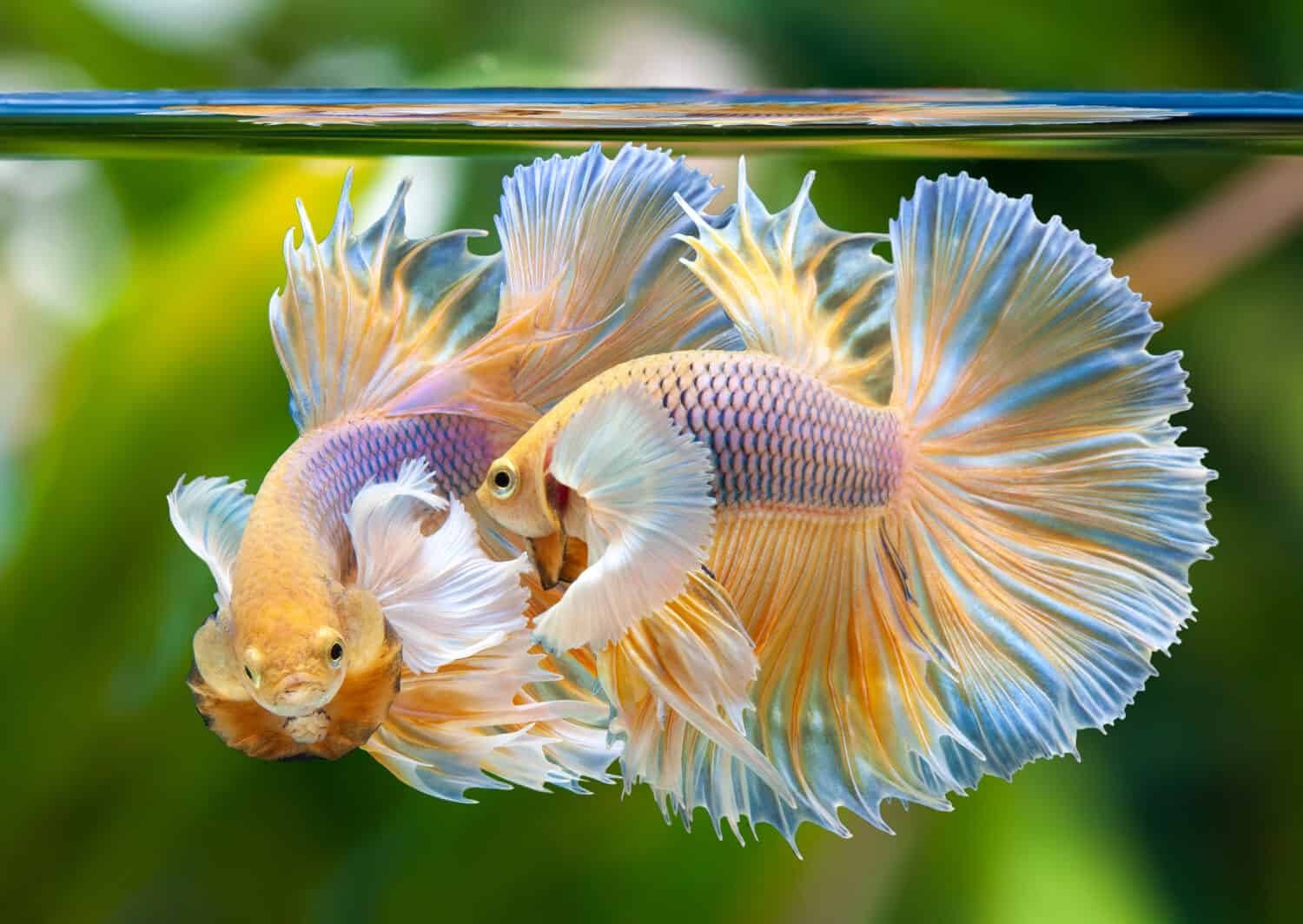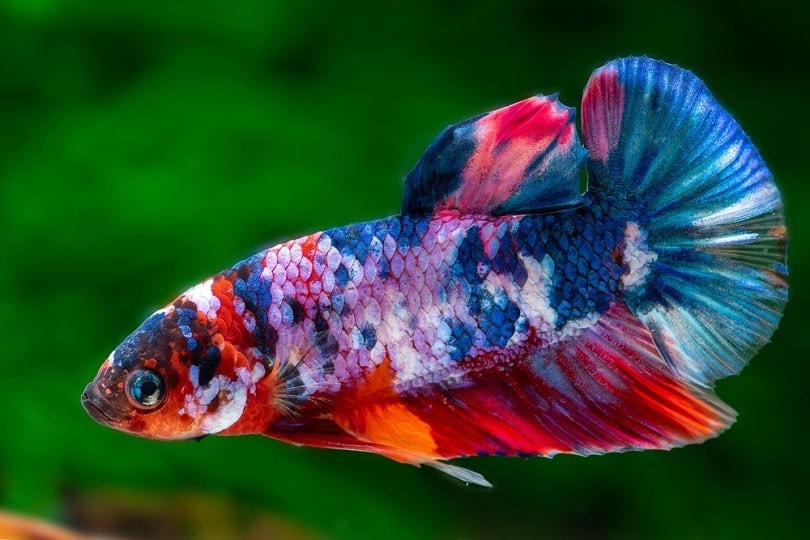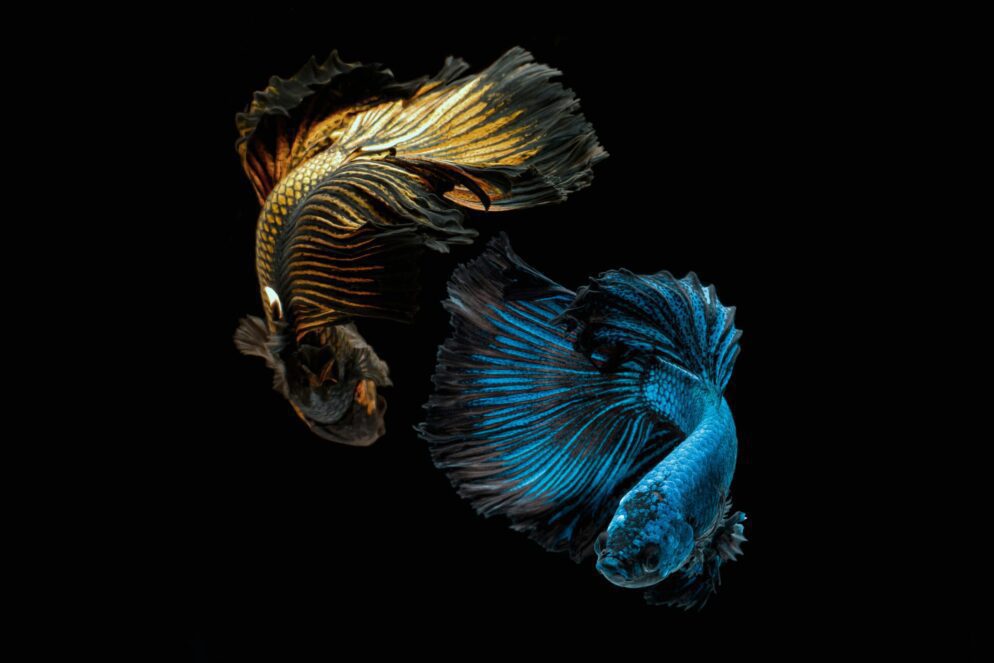Last Updated on January 23, 2024 by Dog Lover
Most Expensive Betta Fish: Dazzling Denizens of the Deep (and Their Hefty Price Tags)
Picture a creature more dazzling than a jewel, gliding through the water with fins that billow like ethereal robes. Its scales shimmer in a kaleidoscope of colors, each one seemingly more vibrant than the last.
This isn’t a figment of imagination; it’s the captivating reality of the most expensive Betta fish varieties. These aquatic marvels aren’t merely stunning eye candy; they command price tags that would make even the most seasoned aquarist blink in disbelief.
Yet, for passionate collectors and dedicated breeders, these rare Betta fish are more than just prized possessions; they’re living testaments to meticulous breeding practices, unwavering dedication, and the boundless beauty of nature.
Prepare to embark on a journey into the extraordinary realm of these high-priced finned wonders. We’ll delve into the captivating characteristics that set them apart, unveil the secrets behind their sky-high value, and explore the unwavering dedication that goes into bringing these living jewels to life.
So, buckle up, fellow fish enthusiasts, and get ready to be mesmerized by the most exquisite Betta fish the world has to offer.
Let’s dive into their shimmering scales, explore their unique stories, and discover the magic that makes them worth their weight in, well, not exactly gold, but something far more precious – the unwavering passion of the hobby itself.
The Fascinating World of Betta Fish
Welcome to the captivating realm of betta fish, where vibrant colors and graceful movements come together to create a truly mesmerizing sight. Among the numerous varieties of betta fish, there is one that stands out from the rest in terms of rarity and beauty: the most expensive betta fish.
In this article, we will delve into the enchanting world of these exquisite creatures, exploring their unique characteristics, the factors that contribute to their high price, and where you can find them.
The Allure of the Most Expensive Betta Fish
What makes the most expensive betta fish so special? These extraordinary creatures possess a dazzling array of colors, ranging from vibrant blues and fiery reds to striking purples and iridescent greens. Their fins are adorned with intricate patterns, resembling delicate works of art. Each betta fish is truly a masterpiece of nature.
Not only are they visually stunning, but the most expensive betta fish also exhibit captivating behaviors. With their long, flowing fins, they gracefully glide through the water, captivating anyone who has the pleasure of observing them. Their unique personalities and interactive nature make them popular pets among fish enthusiasts.

The Factors that Determine Price
Several factors contribute to the high price of the most expensive betta fish. One of the primary factors is their rarity. These fish are bred in limited quantities, making them highly sought after by collectors and enthusiasts.
Additionally, the intricate patterns and vibrant colors of these bettas require meticulous breeding and careful genetic selection, further increasing their value.
Another factor that influences the price is the age and size of the fish. Larger and older bettas are generally more expensive, as they have had more time to develop their unique colors and patterns. The overall health and condition of the fish also play a role in determining its value.
Where to Find the Most Expensive Betta Fish
If you’re eager to add one of these rare and stunning creatures to your collection, you’ll be pleased to know that there are various reputable breeders and specialized fish stores that offer the most expensive betta fish for sale. It’s essential to do thorough research and choose a trustworthy source to ensure the health and authenticity of your new pet.
When purchasing a betta fish, consider factors such as the breeder’s reputation, the fish’s lineage, and the conditions in which they were raised. By selecting a reputable source, you can be confident that you are acquiring a genuine and well-cared-for betta fish.
The Allure of Rarity: Why Some Betta Fish Cost a Fortune
Before we delve into the specific breeds, let’s understand what makes certain Betta fish prohibitively expensive. It boils down to a combination of factors:
- Rarity: Certain color mutations, fin types, and genetic traits occur infrequently, making these Betta fish highly sought-after. The rarer the trait, the steeper the price.
- Breeding Challenges: Producing these exceptional Betta fish often requires meticulous breeding practices, specialized environments, and years of experience. Breeders invest significant time, effort, and expertise, reflected in the final price.
- Show Quality: Many of these exorbitantly priced Betta fish are bred for competitions, judged on their flawless form, vibrant colors, and graceful movements. Winning fish at prestigious shows can fetch even higher prices due to their champion status.
Now, let’s meet the majestic Betta fish that command jaw-dropping prices:
The Elusive True Purple Betta: A Royal Hue Worth a King’s Ransom

The Holy Grail of the Betta world, the true purple Betta is shrouded in mystery and legend. This ethereal fish boasts a coat of genuine purple, a color rarely seen in the Betta kingdom.
Achieving this mesmeric hue requires years of selective breeding and a touch of genetic magic, making it incredibly difficult to obtain. Prices for a true purple Betta can soar into the thousands of dollars, with some specimens reaching five figures.
The Majestic Fantail Betta: A Double Dose of Finery

Imagine a Betta fish with not one, but two flowing caudal fins. That’s the breathtaking spectacle of the fantail Betta. This genetic anomaly results in a breathtaking tail display, resembling a luxurious fan.
While not as elusive as the true purple Betta, fantail Bettas are still quite rare, with prices ranging from hundreds to thousands of dollars depending on their fin quality and overall aesthetics.
The Dazzling Dragon King Crown Betta: A Crown Fit for an Aquatic King

Adorned with metallic scales that shimmer like a dragon’s hoard, the Dragon King Crown Betta is a sight to behold. This regal fish possesses an iridescent sheen, particularly pronounced on its head and fins, giving it an air of royalty.
Preise for Dragon King Crown Bettas vary depending on the intensity of their metallic sheen and finnage, but they can easily command hundreds of dollars.
The Enchanting Butterfly Betta: A Symphony of Color and Grace

With fins that resemble delicate butterfly wings, the butterfly Betta flits through the water like a living dream. This ethereal fish comes in a variety of vibrant colors, often featuring intricate patterns and iridescent accents.
Butterfly Bettas are relatively more common than some of the other breeds on this list, but their exquisite beauty still pushes their prices into the hundreds of dollars range.
The Mystical Kachen Worachai Plakat Betta: A Living National Treasure

Bred to embody the colors of the Thai flag, the Kachen Worachai Plakat Betta is a national treasure in its homeland. This breathtaking fish showcases a striking combination of red, white, and blue, achieved through meticulous breeding practices.
Owning a Kachen Worachai Plakat Betta is not just about acquiring a magnificent fish; it’s about owning a piece of Thai cultural heritage. Prices for these national icons can range from hundreds to thousands of dollars.
…and many more!
This is just a glimpse into the dazzling world of the most expensive Betta fish.
Frequently Asked Questions
How much do the most expensive betta fish cost?
The price of the most expensive betta fish can vary greatly depending on factors such as rarity, coloration, and size. Prices can range from $100 to several thousand dollars.
Are the most expensive betta fish difficult to care for?
While betta fish require specific care, the most expensive betta fish do not have any additional care requirements compared to other betta varieties. With proper knowledge and attention to their needs, they can thrive in a well-maintained aquarium.
Can I breed the most expensive betta fish?
Yes, it is possible to breed the most expensive betta fish. However, breeding these rare varieties requires expertise, as it involves careful genetic selection and meticulous breeding practices. It is recommended to seek guidance from experienced breeders if you are interested in breeding these exquisite fish.
Are there any risks involved in purchasing the most expensive betta fish?
When purchasing any live animal, there are inherent risks involved. It is crucial to choose a reputable breeder or fish store to minimize the chances of acquiring a fish with health issues. Additionally, ensure that you have the necessary knowledge and resources to provide proper care for your betta fish.
Can I display the most expensive betta fish in a community aquarium?
It is generally not recommended to keep the most expensive betta fish in a community aquarium. These bettas can be more aggressive and may not tolerate the presence of other fish. It is best to provide them with their own spacious and well-maintained aquarium to ensure their well-being.
In Conclusion
The most expensive betta fish are truly a sight to behold. With their vibrant colors, intricate patterns, and captivating behaviors, they have captured the hearts of fish enthusiasts worldwide.
If you’re lucky enough to own one of these rare and stunning creatures, ensure that you provide them with the care and attention they deserve. The world of betta fish is waiting to be explored, so dive in and discover the wonders of these magnificent creatures.
Sources:
General Betta Care:
- Betta splendens (Siamese Fighting Fish): https://en.wikipedia.org/wiki/Betta
- Caring for Betta Fish: https://www.thesprucepets.com/fish-and-aquariums-4162060
- Betta Fish Care Guide: https://bettafish.org/care/
Specific Breeds:
- True Purple Betta: https://fishlab.com/purple-betta/
- Fantail Betta: https://www.liveaquaria.com/product/7979/?pcatid=7979
- Dragon King Crown Betta: https://www.aquariumsource.com/crowntail-betta/
- Butterfly Betta: https://www.youtube.com/watch?v=cHcHJELfxbA
- Kachen Worachai Plakat Betta: https://a-z-animals.com/blog/the-most-expensive-betta-fish-ever-sold-will-blow-your-mind/
Betta Shows and Competitions:
- International Betta Congress (IBC): https://www.ibcbettas.org/
- Betta splendens International Show (BSIS): https://www.ibcbettas.org/shows/
- Betta Club of America (BCA): https://www.ebay.com/str/bettausa

















